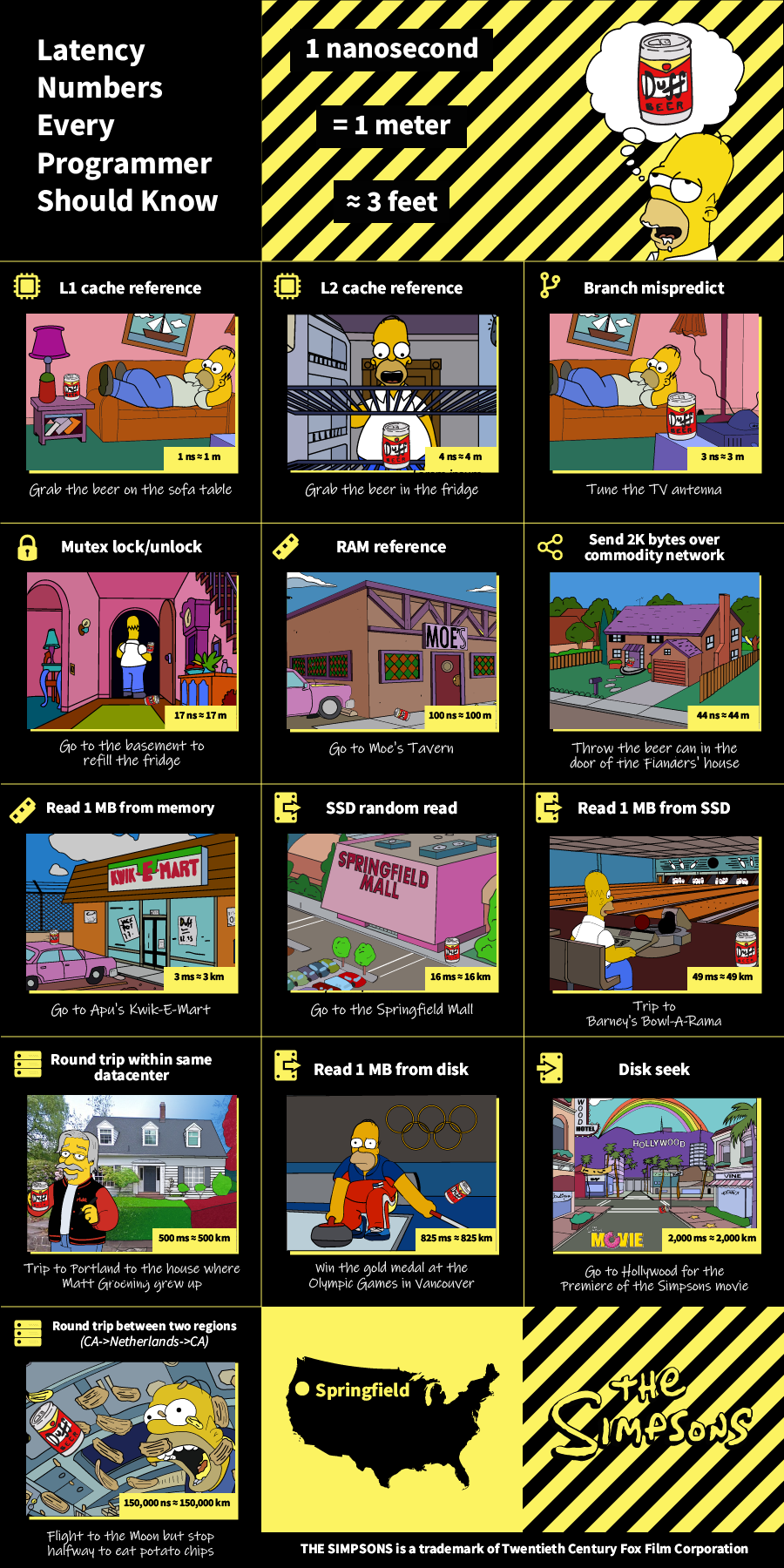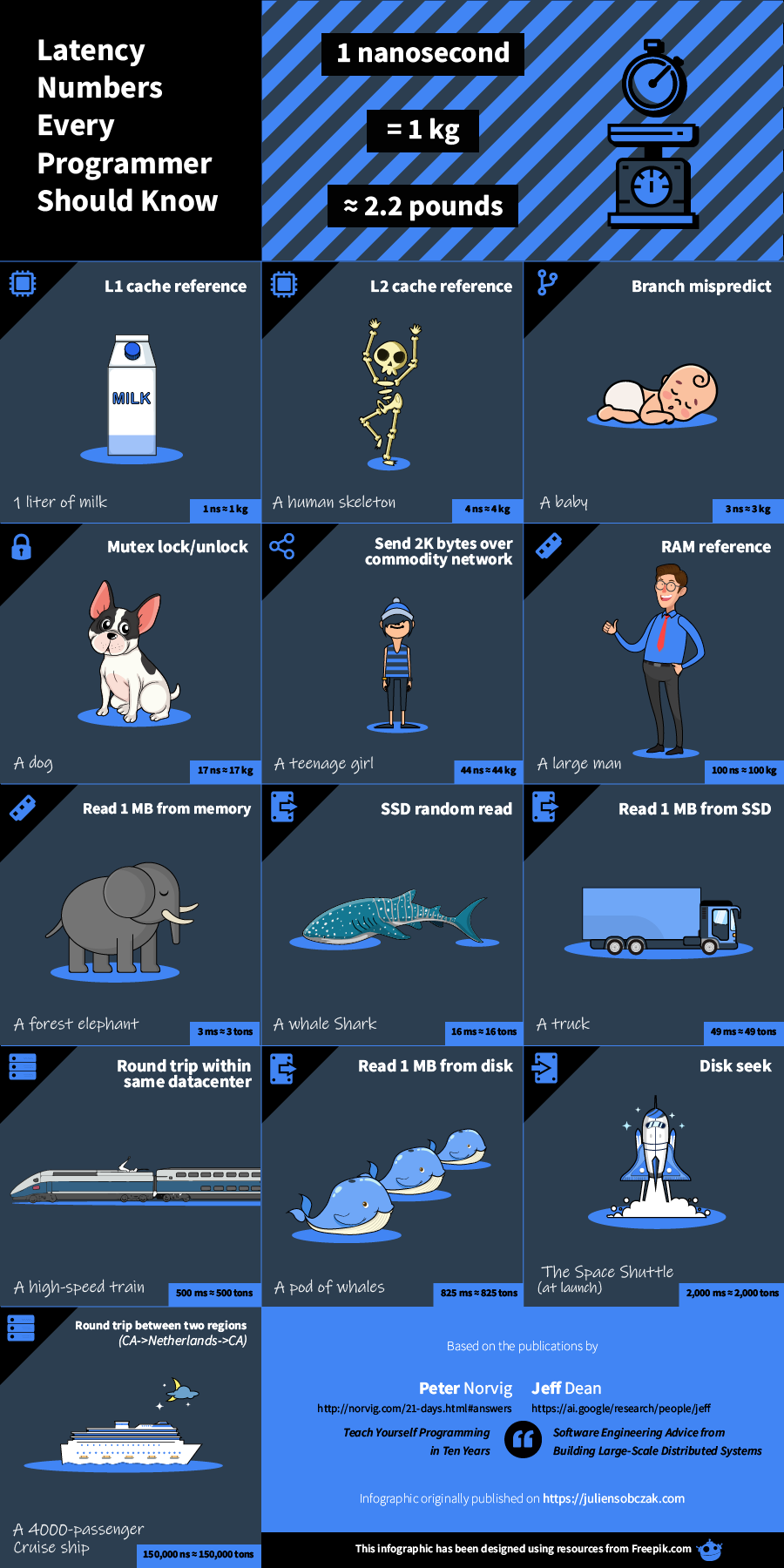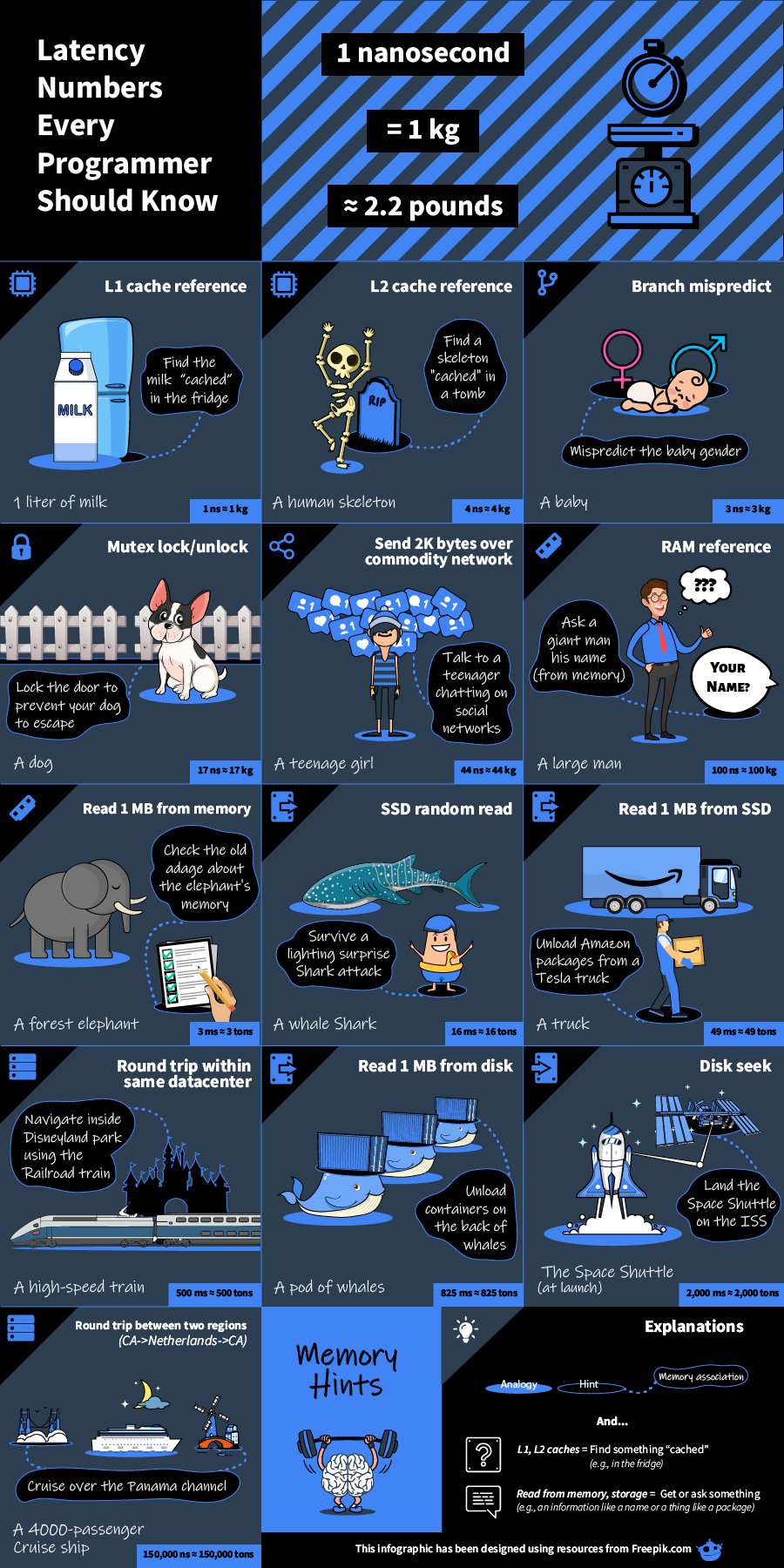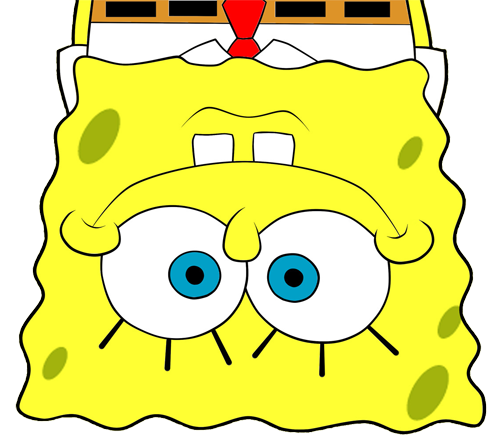Human life is a journey.
Metaphor: A figure of speech in which a word or phrase literally denoting one kind of object or idea is used in place of another to suggest a likeness or analogy between them.
Metaphors are everywhere. But metaphors are so ubiquituous we often fail to notice them. My initial idea for this article was to demonstrate how metaphors are useful when learning. I researched on the subject and quickly came to this conclusion: metaphors are not useful, they are indispensable. We speak, understand, learn, and reason with metaphors. Since I started writing this article, I came across hundreds of metaphors — in books, in TV series, in conversations. I learned to notice them again, and I hope this article will help you see the metaphors under a new light.
A Few Examples
Metaphors can be found in the literature, but this is just the tip of the iceberg. We find them also:
-
In songs.[1]
Welcome to the Hotel California Such a lovely place (Such a lovely place) Such a lovely face They livin’ it up at the Hotel California What a nice surprise (what a nice surprise)
— The Eagles
Hotel CaliforniaThe Eagles compare the brittle, temporary celebrity so many people are pursuing in Hollywood to a short-stay in a hotel. No one knows how long they are going to be famous, so they have to make the most out of it.
-
In movies.[2]
The Truman Show title is a play word with a "True Man”, the main character living a true, artificial life until finding the stairs representing freedom. Other films such as Inception, Groundhog Day, Avatar, The Shining are good examples too. I particularly enjoyed Pixar’s Inside Out. “The movie is a metaphor for human emotions and intellectual feelings. Each color represents one emotion that we feel similar to how the main character Riley’s emotions depend on the emotions or actions of Joy, Fear, Anger, Disgust, and Sadness who live in Headquarters, a metaphor for the brain and advise her through everyday life.” Similarly, in Ralph Breaks the Internet, the two main characters are evolving in a physical, fictional world where we retrieve everything that makes Internet such a particular place, but in a world close to our real-world, where network packets transit in aerial highways.
-
In quotes.
All religions, arts and sciences are branches of the same tree.
— Albert Einstein
PhysicistAll the world’s a stage, and all the men and women merely players.
— William Shakespeare
PoetConscience is a man’s compass.
— Vincent Van Gogh
PainterThe negative is the equivalent of the composer’s score, and the print the performance.
— Ansel Adams
Photographer -
And also in presidential speeches, cartoons, TV series, advertisements, comedy shows, symbols, and even in dream interpretions!
But a metaphor can be as simple as Love is a journey, Love is a garden, Love is an experiment, and we often use this strategy with kids — The classroom was a zoo, You are my sunshine, Life is a rollercoaster [3] — complex notions expressed using simple words kids can understand.
These examples demonstrate you can’t escape metaphors. But why are they so effective?
A Little Theory
The title of this article could have been called The Power of Metaphors, Similes, and Analogies in Learning, but usually, the shorter, the better. We should, however, explain the differences between these figures of speech before going any further.
|
Metaphor, Simile, or Analogy?
— Dr Mardy Grothe
Metaphors Be With You To illustrate this short definition, Mardy Grothe uses a quotation written by Rudyard Kipling: “Words are, of course, the most powerful drug used by mankind.” The metaphor is A word is a drug. A simile would say, A word is like a drug, and an analogy would say, Words are to the mind as drugs are to the body. Similarly, hard as a rock is a simile, and reading is to the mind what exercise is to the body is an analogy. (For simplicity, I will use the term "metaphor" for the rest of this article to refer to both metaphors and its like-minded cousins). |
Metaphors are a way to talk about one thing by describing something else. In fact, similes and analogies are metaphors that admit explicitly this comparison. Someone might say that metaphors are unproductive since they define a word using a different word, but that is exactly the reason why they are working, to the sole condition you are already familiar with the second word (the comparison). For example, the metaphor Life is a journey is meaningful only if you have already traveled to a different place.
In essence, one domain of experience (the source) is used to understand another domain of experience (the target). On the previous example, Journey is the source domain and Life is the target domain. The key point to remember is familiarly is essential to good metaphors. To create a powerful metaphor, you must find something that is broadly understood like the human body (the heart of the problem), the wellness (a healthy society), the nature (the fruit of her labor), the domain of construction (to be in ruins financially), the money (spend time), the food (a recipe for success), the weather (a foggy idea). They all serve as good source domains that can be used to explain abstract target domains like love, relationship, time, life, and so much more.
The familiarity principle explains why metaphors are so efficient. Our brain operates using associations, interconnecting neurons together to form a giant network of knowledge. Learning is essentially connecting something new with something old. In the same way, metaphors use something we already know to understand something we ignore. Our brain is alike a metaphor machine. He loves making associations and using metaphors is the best way to play with him.
In the TED animation The Art of the Metaphor, Jane Hirshfield declares "[T]here’s a paradox to metaphors. They almost always say things that aren’t true." (e.g., Have you ever seen an elephant in the room?) He adds "Metaphors are art, not science. […] They get under your skin by ghosting right past the logical mind." Whether you are learning or teaching, you definitely should seek for metaphors as we will illustrate with the following examples. But metaphors are not just for learning something new, they can also be used to explain something already known. Stephen King, in his memoirs On Writing, underlines the role of metaphors to enable people to “see an old thing in a new and vivid way.” Let‘s see how.
A Few More Examples
When We speak…
In a classic book on the subject, Metaphors We Live By, the authors highlight the crucial role of metaphors in languages, in a way most of us barely notice it. For example, if you ignore the Love is a journey metaphor, how can you understand the expressions "Look how far we’ve come" or "Where are we now?” You can know the meaning of every one of those words and still miss the meaning of the expression. Metaphors are an essential part of any language and you have to decipher them to communicate efficiently.
Now, consider the metaphor Argument is war.
Your claims are indefensible. He attacked every weak point in my argument. His criticisms were right on target. I demolished his argument. I’ve never won an argument with him. He shot down all of my arguments.
With such a metaphor, it comes as no surprise that having an argument is often dreaded in the workplace. Metaphors have profound cultural implications. For example, the English language uses extensively the spatial metaphor Up is better and Down is worse:
-
happy/sad (I’m feeling up. I’m feeling down. I fell into a depression),
-
healthy/sick (He’s in top shape. He came down with the flu).
In particular, we consider More is up, and Less is down (My income rose last year. His income fell last year.) More is better is coherent with More is up and Good is up, while Less is better is not coherent with them. These are values deeply embedded in our culture, but different cultures may use inverse metaphors. For others, Less is better is true with respect to material possessions. Different cultures, different metaphors.
In the same book, the authors demonstrate metaphors are a powerful language construction.
Metaphors can be composed. Argument is a journey (We proceeded in a step-by-step fashion to arrive at a disturbing conclusion) and A journey defines a path (He strayed from the path, He’s gone off in the wrong direction, I’m lost), therefore Argument defines a path (He strayed from the line of argument, We’ve gone off in the wrong direction, I’m lost).
Metaphors can also overlap. Argument is a journey (So far, we’ve seen that) and Argument is a container (That argument has holes in it.) can be put together (At this point, our argument doesn’t have much content).
Each of those metaphors serves a different purpose by highlighting a different aspect of the underlying concept. It is not surprising to find so many metaphors to describe elaborate notions such as love and time.
There are just a few examples present in this book. If you are curious and eager to learn more on the subject, I advise this book. It isn’t an easy reading, and I didn’t understood everything to be honest, but this book really opened my eyes (one more metaphor) on the indispensable role of metaphors in spoken languages. If you are not already convinced, try to spot them in the following paragraph:
This is a shallow argument; it needs more foundation. You haven’t gotten to the deepest points yet—those at the core of the argument. We have to go over these ideas in great depth.
The solution:
-
This is a shallow argument; it needs more foundation. (Argument is a building)
-
You haven’t gotten to the deepest points yet—those at the core of the argument, (Argument is a container).
-
We have to go over these ideas in great depth. (Argument is a journey)
When We Meditate…
Metaphors are popular in meditation, to say the least. The Pali Canon, which is the written record of the Buddha’s teachings, contains over 1000 metaphorical references addressing over 500 different concepts. Recently, I’ve read a dozen books on the subject, and you cannot read a (good) book on meditation without discovering metaphors that make you reconsider the practice. Even when you think you have grasp the theory, there is always a metaphor to prove you wrong. That’s the real power of metaphors.
The following quotes only serve to illustrate how metaphors capture vague, subtle ideas using the familiarity principle to create "ah ha" moments. You don’t need to adhere to any of the sentences that follows. Meditation is not the point of this article — metaphors are.
If you allow a glass of murky stormwater to stand, eventually the dirt settles and you are left with only clear water. It’s the same with meditation…Eventually we discover that the true nature of our mind is nothing except pure clarity, awareness–and bliss.
Buddhism for Busy People: Finding Happiness in an Uncertain World
Breath is the anchor of mindfulness, helping us attach ourselves to the present moment. Sometimes it’s what sailors call a floating anchor, the kind that allows a ship to slow down and not capsize in the storm, when other maneuvers are no longer possible.
Looking at Mindfulness
This is a donut. It is very sweet, and very good. But if you’ve never tasted a donut, you wouldn’t really know how sweet and how good a donut is… meditation is like that.
Film director
A useful metaphor for mindfulness is going into a darkened room and gradually turning up a dimmer switch so that the light reveals more and more of what is in the room.
Mindful Compassion
Mindfulness is like viewing clouds from the perspective of the sky, simply noticing them arising and passing through without any sense of them being good or bad clouds. They are just clouds.
http://silentmindopenheart.org/articles/conc-mind.html
A quick last one for the road, a metaphor to explain meditation using meditation:
There is a joke within mindfulness teaching circles that teaching mindfulness is like selling water by the river. You already know how to do this!
http://ctwatchdog.com/misc/mindfulness-the-art-of-being-in-the-present-moment
As an exercise, try to describe the mind without referring to something else. It’s hard to do that. Metaphors are not useful, they are indispensable. We have a finite number of words to describe in infinite numbers of concepts and emotions. Metaphors are the solution to this dilemna. So, why not use metaphors at work?
When We Work…
In the book Making Truth: Metaphor in Science, American scientist Theodore L. Brown declares metaphors are “[A]t the very core of what scientists do when they design experiments, make discoveries, formulate theories and models, and describe their results to others — in short, when they do science and communicate about it."
To formulate his theory of relativity, Albert Einstein depicted himself riding on a beam of light holding a mirror in front of him. Similarly, Charles Darwin used the branches of a tree to represent the evolution of species, a metaphor known as the Tree of life. "The affinities of all the beings of the same class have sometimes been represented by a great tree," says C. Darwin, "I believe this simile largely speaks the truth."
These two examples illustrate an important point: the simplicity of metaphors can be used to face the complexity of any topic. In fact, using metaphors is surely a far better strategy than using intelligence to be successful at work.
When I Work…
The software landscape is not an exception and we find plentiful of metaphors.
-
The house metaphor. Many development practices (design, architecture) was initially inspired by this analogy. Building a software was compared to building a house, and it is not uncommon to find software architects in the workplace. In practice, this may be not the best metaphor we have used in the software history, far from it (Yes, not all metaphors are useful).
-
The vehicle metaphor. Comparing a program with a car proved to be more useful. You launch a program, even if sometimes it crashes abruptly. Most complex programs integrates an engine (on a kernel) at their core, and communicate with drivers operating devices using buses.
-
The desktop metaphor. Microsoft introduced the desktop metaphor back in the 80’s with Windows 1.0, the first graphical user interface for MS-DOS. This metaphor stands the test of time. We continue to use folders to organize our documents before throwing them in the trash, but now, multi-touch screens have introduced new metaphors: we can now drag, flick, or swipe objects on the screen, mimicking what we will do with physical objects like magazines.
-
Internet metaphors. The Internet is commonly known as the information superhighway, the cyberspace, or more usually as the web in reference to the network of fine threads constructed by a spider. We also compare the Internet to an ocean (to surf the Internet, to navigate the Internet), to a container (to download, to get something from the Internet), to a place (to enter the Internet, to sell something on the Internet, the people on the Internet), and so much more.
-
DevOps metaphors. When a new paradigm emerges, new metaphors serves to smooth the transition by showing that new ideas are not so new. The Pets vs Cattle analogy compares our servers with bovines and the agricultural revolution that took place centuries before. On a similar topic, we can present Kubernetes as a Datacenter operating system, and Cloud computing can be compared to electricity generation, except it uses the Internet to deliver the power and not electrical grids.
We might as well continue to find more examples, but we would probably never finish, so why not put into practice everything we have discussed so far.
A Little Practice
In one of his first talks at Google, Jeff Dean introduced examples of latency numbers, based on the research work from Peter Norvig. These are the "Numbers Every Programmer Should Know", except nobody is really good at memorizing such numbers:
L1 cache reference ............................. 0.5 ns
Branch mispredict ................................ 5 ns
L2 cache reference ............................... 7 ns
Mutex lock/unlock .............................. 100 ns
Main memory reference .......................... 100 ns
Compress 1K bytes with Zippy ................ 10,000 ns
Send 2K bytes over 1 Gbps network ........... 20,000 ns
Read 1 MB sequentially from memory ......... 250,000 ns
Round trip within same datacenter .......... 500,000 ns
Disk seek ............................... 10,000,000 ns
Read 1 MB sequentially from network ..... 10,000,000 ns
Read 1 MB sequentially from disk ........ 30,000,000 ns
Send packet CA->Netherlands->CA ........ 150,000,000 nsA few years later, in 2009, Jeff Dean refreshed these numbers in a similar talk.
Since, numerous persons have published actualized versions to reflect the latest trends. Colin Scott, also working at Google, is one of them, and published an online tool to visualize the evolution of these numbers in time. Here are the actual numbers:
L1 cache reference ............................. 1 ns
Branch mispredict .............................. 3 ns
L2 cache reference ............................. 4 ns
Mutex lock/unlock ............................. 17 ns
Main memory reference ........................ 100 ns
Compress 1K bytes with Zippy ............... 2,000 ns
Send 2K bytes over commodity network .......... 44 ns
Read 1 MB sequentially from memory ......... 3,000 ns
SSD random read ........................... 16,000 ns
Round trip within same datacenter ........ 500,000 ns
Read 1 MB sequentially from SSD ........... 49,000 ns
Disk seek .............................. 2,000,000 ns = 2 ms
Read 1 MB sequentially from disk ......... 825,000 ns
Send packet CA->Netherlands->CA ...... 150,000,000 ns = 150 msHis online tool favors comprehension as he uses little colored squares to make easier to visualize the difference in magnitude between the different values:
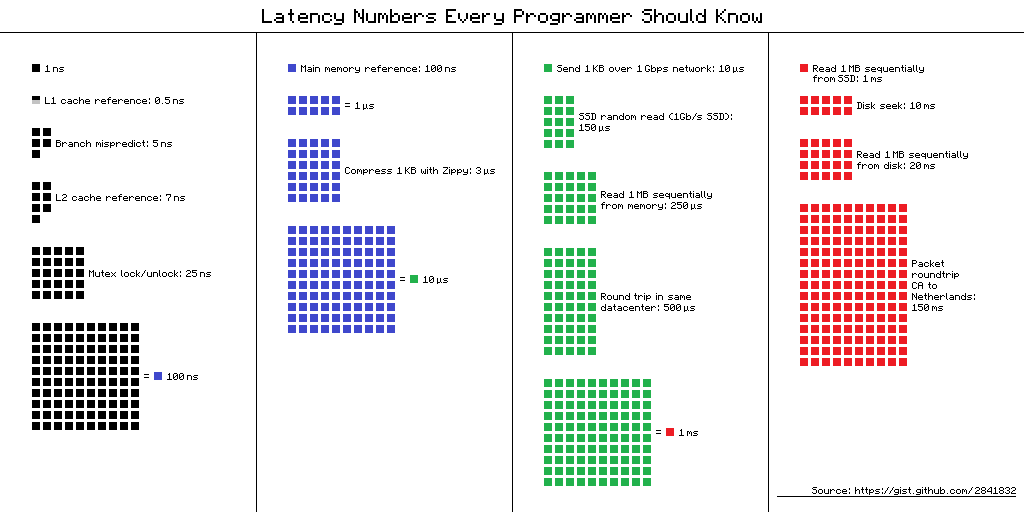
Even if that’s a lot better than the monospace font used by Jeff Dean in his presentation (and reused in this article), this is far from optimal or sufficient for a human brain to remember. Our brain was not devised to retain this kind of information (I doubt it would have been helpful to escape our predators), and the evolution of species requires far more than 200,000 years spent on Earth for such radical changes. Therefore, we need a more effective approach, and guess what, we will use metaphors for that!
But before going on, we should acknowledge those numbers will invariably become obsolete one day. What is important, and what should be kept in mind, is the magnitude of these operations, not their precise value at a single point in time. Analogies are particular useful when learning such abstract information. For example, HDD is a turtle walking when SDD is Usain Bolt sprinting for a gold medal. You should admit It’s far more descriptive than comparing 49 vs 825 nanoseconds. But we can do a lot better!
The Simpson Analogy
Your are Homer Simpson and you want to drink beer.
We will associate the latency with the distance to grab the beer, where 1 nanosecond equals 1 meter. For example, a L1 cache reference (1 ns) means grab the beer on the sofa table (1 meter). The starting point for every distance is always the famous couch in Springfield. But where is Springfield?
After 23 seasons of tantalising secrets, Simpsons creator Matt Groening finally revealed that the town of Springfield, Oregon, was the inspiration for the show’s setting. Matt Groening grew up in a house on Evergreen Terrace in Portland, Oregon - incidentally, the same address as the Simpsons.[4])
Here is the list of analogies:
L1 cache reference (1 ns) … … Grab the beer on the sofa table (1 m) Branch mispredict (3 ns) … … Tune the TV antenna first (3 m) L2 cache reference (4 ns) … … Grab the beer in the fridge (4 m) Mutex lock/unlock (17 ns) … … Go to the basement to refill the fridge (17 m) Send 2K bytes over commodity network (44 ns) … … Throw the can of beer at the door of the Flanders' house (44 m) Main memory reference (RAM) (100 ns) … … Go to Moe’s Tavern (100 m) Read 1 MB sequentially from memory (3,000 ns) … … Go to Apu’s Kwik-E-Mart (3 km) SSD random read (16,000 ns) … … Go to the Springfield Mall (16 km) Read 1 MB sequentially from SSD (49,000 ns) … … Round trip to Barney’s Bowl-A-Rama (49 km) Round trip within same datacenter (500,000 ns) … … Round trip to the house where Matt Groening grew up in Portland (500 km) Read 1 MB sequentially from disk (825,000 ns) … … Drink a beer after the gold medal at the Olympics in Vancouver (825 km) Disk seek (2,000,000 ns) … … Go to Hollywood for the Premiere of the Simpsons movie (2,000 km) Round trip without two regions (150,000,000 ns) … … Flight to the Moon but stop halfway to eat potato chips in zero gravity (150,000 km)
The same information visually depicted:
The Weight Analogy
We now associate the latency with the weight of an object, a person, or an animal (1 nanosecond = 1 kilogram). For example, a L1 cache reference (1 nanosecond) represents a liter of milk (1 kilogram). Here is the list of analogies:
L1 cache reference (1 ns) … … 1 liter of milk (1 kg) Branch mispredict (3 ns) … … a baby (3 kg) L2 cache reference (4 ns) … … a human skeleton (4 kg) Mutex lock/unlock (17 ns) … … a dog (17 kg) Send 2K bytes over commodity network (44 ns) … … a teenager (44 kg) Main memory reference (RAM) (100 ns) … … a tall men (100 kg) Read 1 MB sequentially from memory (3,000 ns) … … a forest elephant (3 tons) SSD random read (16,000 ns) … … a whale shark (16 tons) Read 1 MB sequentially from SSD (49,000 ns) … … a truck (49 tons) Round trip within same datacenter (500,000 ns) … … a high-speed train (500 tons) Read 1 MB sequentially from disk (825,000 ns) … … a pod of whales (825 tons) Disk seek (2,000,000 ns) … … a Space Shuttle (at launch) (2,000 tons) Round trip without two regions (150,000,000 ns) … … a 4000-passenger cruise ship (150,000 ton)
The same information visually depicted:
These analogies (the Simpsons and the weight ones) only help us grasp the orders of magnitude between the different operations. They do nothing to help us remember which operation corresponds to which analogy. If I ask you what represents the human skeleton, it’s not easy at first to recall it corresponds to a L2 cache reference. But if I say you the human skeleton was hidden in a grave, and something that is hidden (cached) corresponds to a cache reference, it becomes easier to recall the analogy. That the power of association, the ultimate memory trick. For example:
Remember the reference unit of one kilogram (easy). Then: Imagine … finding the milk "cached" in the fridge Imagine … mispredicting the sex for a upcoming baby Imagine … finding a human skeleton "cached" in a tomb Imagine … locking the door to prevent your dog to escape Imagine … asking a giant man his name (from his memory) Imagine … a teenager chatting on social network Imagine … checking the old adage about the elephant's memory Imagine … a lighting surprise shark attack Imagine … the Disneyland Railroad train navigating inside the park Imagine … unloading Amazon packages from a Tesla truck Imagine … the Space Shuttle positioning to land on the ISS Imagine … unloading containers on the back of the whales Imagine … doing a Transatlantic cruise over the Panama channel
Let’s try to see how it works in practice. Someone asks you for the performance difference between a disk seek compared to a RAM access. How do you proceed? First, you remember that the base unit is the kilogram. The RAM access makes you think of this giant person to whom you asked for his name. A huge person weights around 100 kilograms. Then, when thinking about the disk seek, you remember the Space Shuttle trying to land on the International Space Station. A Space Shuttle weighs a few thousands of tons (crazy numbers like that are generally easy to remember). So, using your mental calculation aptitude (2,000,000 / 100), you determine a disk seek is 20,000 times slower than a memory access.
That’s it. You may think this association process is useless. Why not simply remember the original numbers instead? Try both ways.
|
Key Takeaways
|
